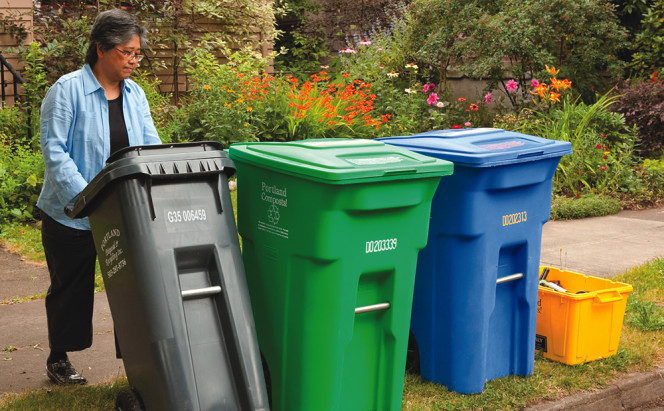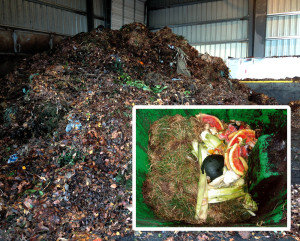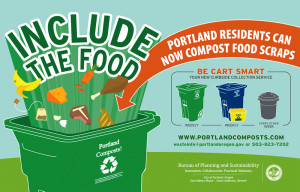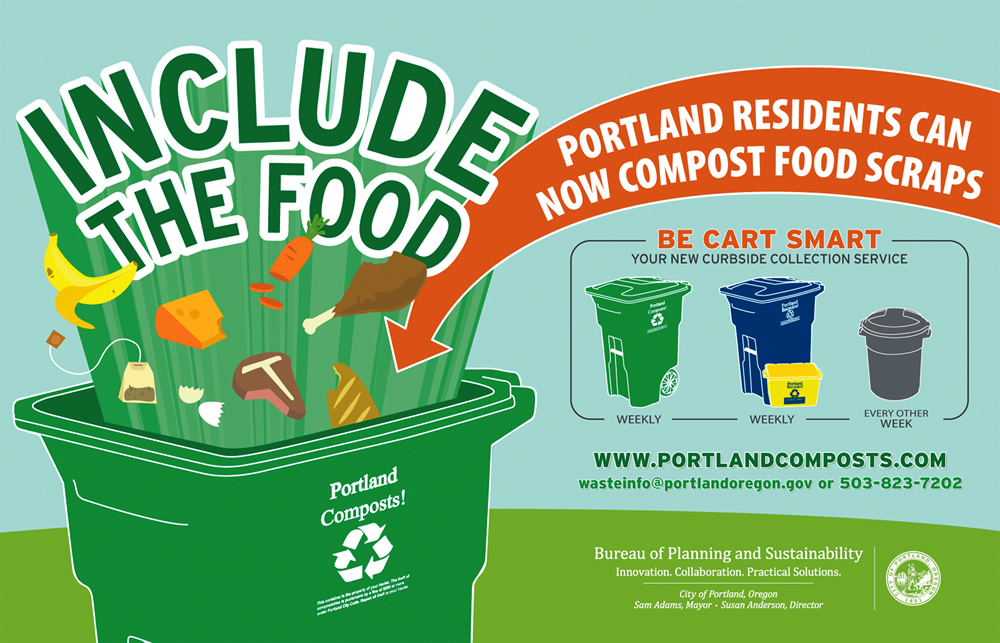Portland, Oregon switched to every other week trash collection with weekly recycling and organics service in 2011. Response to the initiative remains positive.
Katrina Mendrey
BioCycle August 2014

The most common trash cart size for residents participating in the food scraps program is 35 gallons (grey cart on left). Photo courtesy of City of Portland
When the City of Portland, Oregon changed garbage service from weekly to every other week in the fall of 2011, some residents were not pleased. Concerns included vector and odor issues from garbage bins containing pet waste and diapers, as well as grumblings over paying the same rates for what they saw as less service.
But now that the program has been out of the pilot phase for over two years, it’s simply become a way of life for Portland residents, says Arianne Sperry, Coordinator for Portland Recycles!. In fact, Sperry states that changing from weekly to biweekly garbage service and offering weekly collection of yard debris and food scraps and recyclables, has helped keep rates low for the majority of customers participating in the three stream program. For those using the most common trash cart size, 35 gallons, charges dropped by $0.35/month over the past two years. “All in all most residents really appreciate being able to divert organics and set out twice as much yard debris as before,” notes Sperry. “Many are gardeners, they’re big foodies, and they know the organics can be turned into something good so they’re excited about participating.”
The decision to permanently change garbage service to every other week collection came after an extensive 18-month pilot program, which included 4,000 households across four areas of the city. During the pilot, City staff tracked program participation, resident attitudes and perceptions, food scraps capture rate, as well as operational and financial feasibility. During the summer of 2011, the City of Portland made the decision to bring weekly food scraps and every other week garbage collection to the whole city by October 2011.
Anticipating that the program would be expanded, the pilot also tested different messaging strategies for encouraging people to separate food scraps. “Participants did not seem to respond to climate change and traditional environmental messages but liked the idea that their waste was being turned into something valuable,” says Sperry.

Allowable food scraps (insert) include meat, dairy, paper napkins and BPI certified compostable bags that are transparent and tinted green. Contamination recorded at the transfer stations receiving the organics is around one percent. Photos courtesy of City of Portland
This, as well as breaking down the barriers to household composting program participation, have become focal points for the City of Portland’s outreach initiatives. Initially residents were informed of changes via several direct mailings to each residence; radio, print, and transit ads; and through conversations at community events. To handle a five-fold increase in call volumes when the program was rolled out, extra staff was hired to answer phone calls. In addition, each resident received a 2-gallon kitchen pail for collecting scraps that included an information packet on how to collect food scraps for composting and the garbage collection schedule. The kitchen pails were available for the first six months of the program. “Now we encourage people to really figure out what collection container works for their household,” explains Sperry.
Outreach has continued and includes a newsletter released twice yearly with tips and recipes as well as the telephone hotline. “We continue in all of our materials to make food scraps composting a normal thing and work at addressing barriers to getting started,” she adds. “We want to make sure everyone is at least trying it.”
This is particularly important given that the program is completely voluntary. There are no fees for not participating. The only financial incentive is those who participate generate less garbage and therefore pay less for garbage service because they do not have to use a larger container to accommodate their waste.
Limiting barriers to encourage participation was also a consideration in determining the list of allowable items. The list reflects a joint effort between the City of Portland and the facilities responsible for composting residential organics. “We wanted allowable items to work for the facilities that would be receiving the materials but also be understandable and clear for residents,” says Sperry. The success of this collaboration is reflected in low rates of contamination. Residential organic waste contamination recorded at Portland Metro’s two transfer stations is around one percent. Allowable items include meat, dairy, paper napkins and compostable bags that are BPI certified, transparent and tinted green.
Increased Recovery
According to a field study in the fall of 2012, participation is around 80 percent of the 150,000 residential customers, which includes households ranging from single-family homes to four-plexes. Including recycling, Portland’s residential waste recovery rate is around 70 percent based on 2012 numbers, a 17 percent increase from 2010.
However, according to Sperry, close to 80 percent of waste diverted in Portland originates from commercial enterprises, so plans for expanding diversion programs are focusing on businesses and multifamily housing. Currently, 900 businesses participate in Portland’s composting program, over 50 percent of which are accommodation and food service companies. While this only represents a small portion of the over 25,000 businesses in Portland, Sperry notes that many of these only generate a small amount of organic residuals. “Our focus is currently on grocery stores, restaurants and other larger generators,” she says.

Outreach to residents includes a newsletter and a telephone hotline, as well as educational materials such as this poster.
The City is also encouraging residents to “Save More. Live More.” by being conscious, resourceful consumers and reusing. Portland helped develop the U.S. EPA’s Food Too Good to Waste program through participation in the West Coast Climate and Materials Management Forum. “We have decided to incorporate food waste reduction messages into our existing Climate Action Now campaign, which already has a Food Choices initiative (www.portlandonline.com/portlandcan) that is about increasing awareness of and access to healthy sustainable food choices,” notes Sperry. “We are refreshing our Climate Action Now messaging and the campaign will soon feature tips and resources for food waste prevention within the framework of broader food values such as fun, health, nurturing or providing for family, generational/cultural knowledge and celebration, access, saving money, and reconnecting relationships with food, family and community gatherings.”
Katrina Mendrey is a Contributing Editor to BioCycle.










